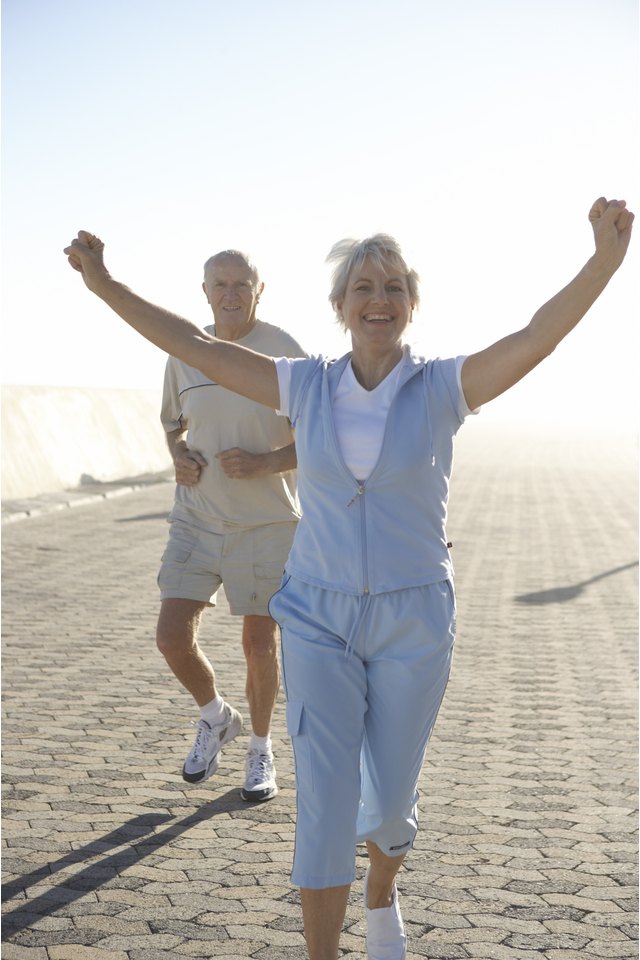Exercise at Age 75: How Much Walking?

Time waits for no couch potato. Whether you're a shuffler or a sprinter, get out there and get moving. Walking is one of the easiest, most accessible exercises for seniors and, at age 75, you could be adding years to your life and prolonging vigor and independence with a daily stroll. Start by checking in with your health-care provider for an all-clear, lace up a decent pair of sneakers, grab a willing friend and burn some rubber on a neighborhood sidewalk or at the mall.
Active Aging
The age cohort of those 75 and over is one of the fastest-growing segments of the American population. With advanced age comes an increased mandate to preserve or improve fitness with an exercise program. Walking, especially brisk or vigorous walking, supplies important benefits for the fit and not-so-fit who want to age more gracefully. University of New Mexico exercise science professor Len Kravitz reports that regular physical activity for seniors, 65 to 75 and up, can reduce risks for cancer, heart disease, type 2 diabetes, hypertension, obesity, osteoporosis, osteoarthritis and high cholesterol. The cardiovascular endurance that results from an aerobic activity such as walking can prevent falls, improve gait and balance, promote sleep and a positive mental state, lower stress, depression and anxiety, and eliminate or delay the need for long-term care.
Big Gulps and Little Bites
Jump in or stick a toe in but try to log at least 10,000 steps a day. Strap on a pedometer or just follow the recommendations of the Centers for Disease Control and Prevention and Britain's National Health Service -- both advocate 150 minutes of moderate-intensity aerobic exercise, such as brisk walking, weekly for older adults. You can bundle those minutes into a half-hour session five days a week or break it up into 10-minute hikes as often as your schedule or endurance level permits. As long as the minutes add up, you've logged your quota -- and you can multitask by combining your walk with a trip to the store, walking the dog, or chatting with a fitness buddy on a circuit around the mall.
Athlete's Attitude
Treat walking sessions like any sport -- maximize your gains by lowering your risk for injury. Warm up with a slow start and gradually increase the pace until you are jogging, or ambling, at full throttle. Time yourself starting when you hit your stride, and the extra warm-up period turns into bonus fitness minutes. As you reach the end of the day's hike, begin to slow down until you are walking at normal speed, not at bracing aerobic velocity. Finish up with a few gentle stretches to keep your leg muscles limber and get the kinks out of your back and shoulders. Don't be a jock and wind up injured, but do challenge yourself to go the distance at your own max speed and cool down carefully at the end of each session.
Better Brains
At three-quarters of a century, you can still walk yourself into a better brain. Researchers at the University of Otago in New Zealand found that aerobic exercise boosts scores on mental tests for the elderly, but that stretching and toning classes didn’t yield the same results. Studies analyzed included populations from 18 to 79 years old and 60 to 90 years old and showed that participants improved cognitive function for working memory, task switching, selective attention and other mental abilities. The subjects were tested after interludes of regular aerobic exercise, typically brisk walking sessions over a period of months. Benefits of the enhanced executive function included better performance in tasks associated with driving, and improved ability to handle independent living.
References
- Beth Israel Deaconess Medical Center: Women Can Improve Heart Health While They "Walk and Talk"
- University of New Mexico: The Age Antidote
- NHS Choices: Physical Activity Guidelines for Older Adults
- Oxford Journals: Exercise for the Elderly: An Update
- Psychonomic Bulletin & Review: Benefits of Regular Aerobic Exercise for Executive Functioning in Healthy Populations
- NHS Choices: Walking for Health
- Centers for Disease Control and Prevention: How Much Physical Activity Do Older Adults Need?
Writer Bio
Benna Crawford has been a journalist and New York-based writer since 1997. Her work has appeared in USA Today, the San Francisco Chronicle, The New York Times, and in professional journals and trade publications. Crawford has a degree in theater, is a certified Prana Yoga instructor, and writes about fitness, performing and decorative arts, culture, sports, business and education .
